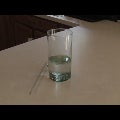Introduction: The Confuzzle
Simplicity and confusion don't often go hand in hand. Here's a confusing puzzle, or "confuzzle", that can be made in minutes. Although it involves simple geometric principles, it is surprising and even baffling to some people. In short, it's a quick, easy project that is tons of fun to show others.
Here's a short video showcasing the presentation and effect of the puzzle:
Step 1: What You Need
1) Two different colors of posterboard (each measuring at least 8.5" x 8.5").
2) Scissors
3) Pencil
4) Ruler
5) Black magic marker
Step 2: Measuring and Cutting
Connect the dots as shown in one of the photos below. This will create a slanted cross pattern.
Use scissors to cut out the square . Then create four pieces by cutting along the remaining lines. The pictures below show all of the necessary dimensions.
Step 3: Creating a Background Frame
Framing the confuzzle is essential. To do this, create a background with a frame by keeping the square "intact" and tracing it on another piece of poster board. Use a black magic marker to trace it. White posterboard works very well for this. Then cut out the square (leaving the black marker lines visible).
Another option is to trace it before you cut the original square into four pieces. This is actually easier.
Step 4: Presenting the Confuzzle
With the puzzle assembled as a square, rotate each of the four pieces 180 degrees and line them up together. They will fit perfectly inside the background frame, but there will be an open spot in the center. Rotate each piece 180 degrees again and the open spot will not be there. This is the baffling part to most people.
How is it possible for the four pieces to fill the background frame completely and then, when rotated, not fill the frame completely? Shouldn't the physical area be the same no matter how the pieces are arranged? These are questions that you and others may ask yourself/themselves. Of course the area is the same. It's just confuzzling!
Again, here's a short video showcasing the presentation and effect of the puzzle. Enjoy!:





